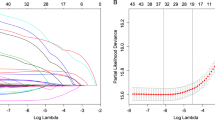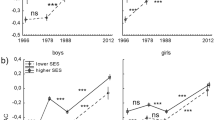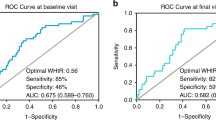Abstract
Background/Objective:
Mid-upper-arm circumference (MUAC) is a simple method of assessing nutritional status in children above 6 months of age. In 2007 World Health Organization (WHO) introduced a MUAC z-score for children above 3 months of age. We evaluated whether MUAC or MUAC z-score had the best ability to identify children with high short-term mortality risk in Guinea-Bissau.
Subjects/Methods:
The Bandim Health Project visits children 3-monthly until 3 years of age. MUAC is measured and deaths are registered. We studied a high-mortality cohort of children born in 1995–96 and a lower mortality cohort of children born in 2005–06. The prognostic ability of MUAC and MUAC z-score to predict mortality within 1 and 3 months after the MUAC assessment were compared by area under the receiver operating characteristic curve, sensitivity and positive predictive value.
Results:
Compared with MUAC z-score, MUAC identified as malnourished more girls than boys (prevalence ratio (PR)=1.74 (1.52;2.01)) and more children aged 6–11 months than children aged 12–35 months (1.59 (1.38;1.82)). There was no difference in the prognostic ability of MUAC and MUAC z-score to predict mortality for children aged 6–35 months. The prognostic ability was higher when mortality was lower. MUAC performed well in the youngest infants.
Conclusion:
In the age group 6–35 months, MUAC and MUAC z-score had the same prognostic ability to predict short-term mortality. As MUAC is easier to use in field settings, there is no need to use MUAC z-score to identify children with a high-mortality risk.
This is a preview of subscription content, access via your institution
Access options
Subscribe to this journal
Receive 12 print issues and online access
$259.00 per year
only $21.58 per issue
Buy this article
- Purchase on Springer Link
- Instant access to full article PDF
Prices may be subject to local taxes which are calculated during checkout



Similar content being viewed by others
References
Berkley J, Mwangi I, Griffiths K, Ahmed I, Mithwani S, English M et al. Assessment of severe malnutrition among hospitalized children in rural Kenya: comparison of weight for height and mid upper arm circumference. JAMA 2005; 294: 591–597.
Jelliffe DB . The assessment of the nutritional status of the community (with special reference to field surveys in developing regions of the world). Monogr Ser World Health Organ 1966; 53: 3–271.
de OM, Yip R, Mei Z . The development of MUAC-for-age reference data recommended by a WHO Expert Committee. Bull World Health Organ 1997; 75: 11–18.
Hall G, Chowdhury S, Bloem M . Use of mid-upper-arm circumference Z scores in nutritional assessment. Lancet 1993; 341: 1481.
World Health Organization WHO Multicentre Growth Reference Study Group. WHO Child Growth Standards: Length/height-for-age, weight-for-age, weight-for-length, weight-for-height and body mass index-for-age: Methods and development 2006: World Health Organization: Geneva.
World Health Organization WHO Multicentre Growth Reference Study Group. WHO Child Growth Standards: Head circumference-for-age, arm circumference-for-age, triceps skinfold-for-age and subscapular skinfold-for-age: Methods and development 2007: World Health Organization: Geneva.
World Health Organization and United Nations Children′s Fund WHO child growth standards and the identification of severe acute malnutrition in infants and children 2009: World Health Organization: Geneva.
WHO. World Health Organization Reference values in health emergency 2010 10 May 2010. Ref Type: Internet Communication.
WHO. World Health Organization Assessment and surveillance of nutritional status in emergencies 2010 10 May 2010. Ref Type: Internet Communication.
Heagerty PJ, Zheng Y . Survival model predictive accuracy and ROC curves. Biometrics 2005; 61: 92–105.
Pelletier DL . The relationship between child anthropometry and mortality in developing countries: implications for policy, programs and future research. J Nutr 1994; 124: 2047S–2081SS.
Acknowledgements
The study received funding from The Danish Medical Research Council and Augustinus Fonden. JR received a Danida Travel Grant. PA holds a research professorship grant from the Novo Nordisk Foundation. CB is funded through an ERC Starting Grant (ERC-2009-StG-243149). The sponsors had no role in the study design, data collection, data analysis, data interpretation, or the writing of the report.
Author information
Authors and Affiliations
Corresponding author
Ethics declarations
Competing interests
The authors declare no conflict of interest.
Additional information
Contributors: PA and AR supervised the data collection. CBS, PA and ABF designed the study. AA, JR and HR did the statistical analysis, and JR wrote the first draft of the paper. All authors contributed to and approved the final version of the paper.
Supplementary Information accompanies the paper on European Journal of Clinical Nutrition website
Supplementary information
Rights and permissions
About this article
Cite this article
Rasmussen, J., Andersen, A., Fisker, A. et al. Mid-upper-arm-circumference and mid-upper-arm circumference z-score: the best predictor of mortality?. Eur J Clin Nutr 66, 998–1003 (2012). https://doi.org/10.1038/ejcn.2012.95
Received:
Revised:
Accepted:
Published:
Issue Date:
DOI: https://doi.org/10.1038/ejcn.2012.95
Keywords
This article is cited by
-
Dietary acid load in children with chronic kidney disease: its association with nutritional status and health-related quality of life
Pediatric Nephrology (2023)
-
Do we need to reconsider the CMAM admission and discharge criteria?; an analysis of CMAM data in South Sudan
BMC Public Health (2020)
-
Concordance between estimates of acute malnutrition measured by weight-for-height and by mid-upper arm circumference after age adjustment: population-representative surveys from humanitarian settings
BMC Nutrition (2019)
-
Mid-Arm Circumference and All-Cause, Cardiovascular, and Cancer Mortality among Obese and Non-Obese US Adults: the National Health and Nutrition Examination Survey III
Scientific Reports (2017)
-
Anthropometric indices and measures to assess change in the nutritional status of a population: a systematic literature review
BMC Nutrition (2016)



